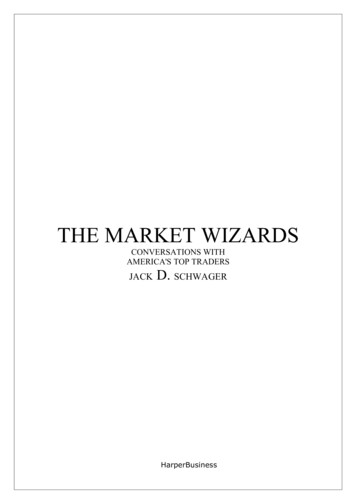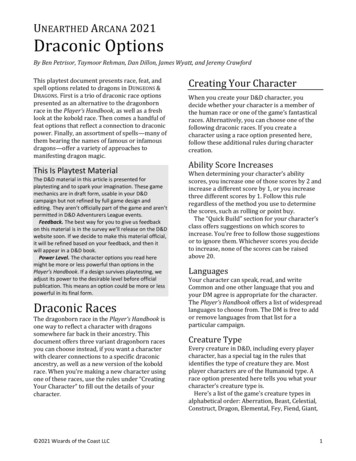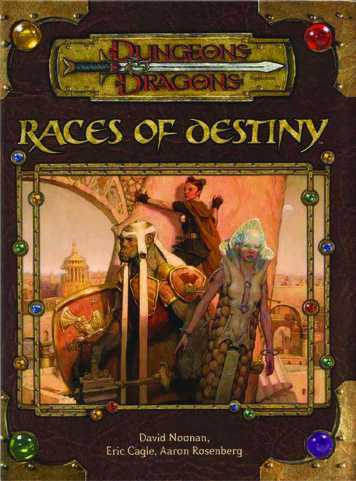
Transcription
THE MARKET WIZARDSCONVERSATIONS WITHAMERICA'S TOP TRADERSJACKD. SCHWAGERHarperBusiness
You've got to learn how to fall, before you learn to fly.One man's ceiling is another man's floor.—Paul Simon—Paul SimonIf I wanted to become a tramp, I would seek information and advice from the most successful tramp I couldfind. If I wanted to become a failure, I would seek advice from men who had never succeeded. If I wanted to succeedin all things, I would look around me for those who are succeeding and do as they have done.—Joseph Marshall Wade(as quoted in a Treasury of Wall Street Wisdomedited by Harry D. Schultz and Samson Coslow)2
ContentsPreface.4Acknowledgments.6Prologue.7My Own Story.8Part I-Futures and Currencies.10Taking the Mystery Out of Futures.11The Interbank Currency Market Defined.11Michael Marcus - Blighting Never Strikes Twice.13Bruce Kovner-The World Trader.27Richard Dennis-A Legend Retires.39Paul Tudor Jones-The Art of Aggressive Trading.50Gary Bielfeldt-Yes, They Do Trade T-Bonds in Peoria.58Ed Seykota-Everybody Gets What They Want.62Larry Hite-Respecting Risk.70Part II-Mostly Stocks.76Michael Steinhardt-The Concept of Variant Perception.77William O'Neil-The Art of Stock Selection.86David Ryan-Stock Investment as a Treasure Hunt.93Marty Schwartz-Champion Trader.99Part III-A Little Bit of Everything.108James B. Rogers, Jr.-Buying Value and Selling Hysteria.109Mark Weinstein-High-Percentage Trader.122Part IV-The View from the Floor.129Brian Gelber-Broker Turned Trader.130Tom Baldwin-The Fearless Pit Trader.137Tony Saliba-"One-Lot" Triumphs*.143Part V-The Psychology of Trading.150Dr. Van K. Tharp-The Psychology of Trading .151The Trade-A Personal Experience.158Postscript-Dreams and Trading.161Final Word.162Appendix 1-Program Trading and Portfolio Insurance.163Appendix 2 - Options—Understanding the Basics*.1643
PrefaceThere are some amazing stories here:A trader who, after wiping out several times early in his career, turned a 30,000 account into 80 million Afund manager who achieved what many thought impossible—five consecutive years of triple-digit percentage returnsA trader from small-town America who started out on a shoestring and has become one of the world's largest bondtraders A former securities analyst who, during the past seven years, has realized an average monthly return of 25percent (over 1,400 percent armualized), primarily trading stock index futures An electrical engineering graduatefrom МГГ whose largely computerized approach to trading has earned his accounts an astounding 250,000 percentreturn over a sixteen-year period.These are but a sampling of the interviews contained in this book. In his own way, each of the tradersinterviewed has achieved incredible success.What sets these traders apart? Most people think that winning in the markets has something to do withfinding the secret formula. The truth is that any common denominator among the traders I interviewed had more todo with attitude than approach. Some of the traders use fundamental analysis exclusively, others employ onlytechnical analysis, and still others combine the two. Some traders operate on a time horizon measured in hours oreven minutes, while others typically implement positions that they intend to hold for months or even years. Althoughthe trading methodologies varied widely, the forthcoming interviews reveal certain important commonalities in tradingattitudes and principles.Trading provides one of the last great frontiers of opportunity in our economy. It is one of the very few waysin which an individual can start with a relatively small bankroll and actually become a multimillionaire. Of course, onlya handful of individuals (such as those interviewed here) succeed in turning this feat, but at least the opportunityexists.While I hardly expect all readers of this book to transform themselves into super-traders—the world justdoesn't work that way—I believe that these thought-provoking interviews will help most serious and open-mindedreaders improve their personal trading performance. It may even help a select few become super-traders.Jack D. SchwagerGoldens Bridge, NYMay 19894
5
AcknowledgmentsFirst and foremost, I would like to thank Stephen Chronowitz, who pored over every chapter in this book andprovided a multitude of helpful suggestions and editing changes. I am indebted to Steve for both the quantity (hours)and quality of his input. I truly believe that whatever the merits of this work, it has benefited significantly from hiscontributions.I am grateful to my wife, Jo Arm, not only for enduring nine months as a "book widow," but also for being avaluable sounding board—a role she performed with brutal honesty. Sample: "This is the worst thing you ever wrote!"(Needless to say, that item was excised from the book.) Jo Arm possesses common sense in abundance, and I usuallyfollowed her advice unquestioningly.Of course, I would like to express my thanks to all the traders who agreed to be interviewed, without whomthere would be no book. By and large, these traders neither need nor seek publicity, as they trade only for their ownaccounts or are already managing all the money they wish to. In many cases, their motives for participating werealtruistic. For example, as one trader expressed it, "When I was starting out, I found biographies and interviews ofsuccessful traders particularly helpful, and I would like to play a similar role in helping new traders."I wish to express my sincere appreciation to Elaine Crocker for her friendly persuasion, which made some ofthe chapters in this book possible. For advice, leads, and other assorted favors, I would like to thank Courtney Smith,Norm Zadeh, Susan Abbott, Bruce Babcock, Martin Presler, Chuck Carlson, Leigh Stevens, Brian Gelber, MichaelMarcus, and William Rafter. Finally, I would like to thank three traders who were gracious enough to grant me lengthyinterviews, which were not incorporated into this book: Irv Kessler, Doug Redmond, and Martin Presler (the formertwo because, in retrospect, I considered my line of questioning too esoteric and technical; the latter becausepublication deadlines did not permit time for needed follow-up interviews and editing).6
PrologueThe name of the book was The Big Board. . . . It was about an Earth-ling man and woman who werekidnapped by extraterrestrials. They were put on display in a zoo on a planet called Zircon-212.These fictitious people in the zoo had a big board supposedly showing stock market quotations andcommodity prices along one wall of their habitat, and a news ticker, and a telephone that was supposedly connectedto a brokerage on Earth. The creatures on Zircon-212 told their captives that they had invested a million dollars forthem back on Earth, and that it was up to the captives to manage it so that they would be fabulously wealthy whenthey were returned to Earth.The telephone and the big board and the ticker were all fakes, of course. They were simply stimulants tomake the Earthlings perform vividly for the crowds at the zoo—to make them jump up and down and cheer, or gloat,or sulk, or tear their hair, to be scared shitless or to feel as contented as babies in their mothers' arms.The Earthlings did very well on paper. That was part of the rigging, of course. And religion got mixed up in it,too. The news ticker reminded them that the President of the United States had declared National Prayer Week, andthat everybody should pray. The Earthlings had had a bad week on the market before that. They had lost a smallfortune in olive oil futures. So they gave praying a whirl. It worked. Olive oil went up.—Kurt Vonnegut Jr. Slaughterhouse FiveIf the random walk theorists are correct, then Earthbound traders are suffering from the same delusions asthe zoo inhabitants of Kilgore Trout's novel. (Kilgore Trout is the ubiquitous science fiction writer in Kurt Vonnegut'snovels.) Whereas the prisoners on Zircon-212 thought their decisions were being based on actual price quotes—theywere not—real-life traders believe they can beat the market by their acumen or skill. If markets are truly efficient andrandom in every time span, then these traders are attributing their success or failure to their own skills orshortcomings, when in reality it is all a matter of luck.After interviewing the traders for this book, it is hard to believe this view of the world. One comes away witha strong belief that it is highly unlikely that some traders can win with such consistency over vast numbers of tradesand many years. Of course, given enough traders, some will come out ahead even after a long period of time, simplyas a consequence of the laws of probability. I leave it for the mathematicians to determine the odds of traderswinning by the magnitude and duration that those interviewed here have. Incidentally, the traders themselves havenot a glimmer of doubt that, over the long run, the question of who wins and who loses is determined by skill, notluck. I, too, share this conviction.7
My Own StoryRight out of graduate school, I landed a job as a commodity research analyst. I was pleasantly surprised tofind that my economic and statistical analysis correctly predicted a number of major commodity price moves. It wasnot long thereafter that the thought of trading came to mind. The only problem was that my department generally didnot permit analysts to trade. I discussed my frustration over this situation with Michael Marcus (first interview), withwhom I became friends while interviewing for the research position he was vacating. Michael said, "You know, I hadthe same problem when I worked there. You should do what I did—open an account at another firm." He introducedme to a broker at his new firm, who was willing to open the account.At the time, I was earning less than the department secretary, so I didn't exactly have much risk capital. Ihad my brother open a 2,000 account for which I acted as an advisor. Since the account had to be kept secret, Icould not call in any orders from my desk. Every time I wanted to initiate or liquidate a position, I had to take theelevator to the building's basement to use the public phone. (Marcus' solution to the same problem is discussed in hisinterview.) The worst part of the situation was not merely the delays in order entry, which were often nerve-wracking,but the fact that I had to be very circumspect about the number of times I left my desk. Sometimes, I would decideto delay an order until the following morning in order to avoid «rearing any suspicion.I don't remember any specifics about my first few trades. All I recall is that, on balance, I did only a littlebetter than break even after paying commissions. Then came the first trade that made a lasting impression. I haddone a very detailed analysis of the cotton market throughout the entire post-World War П period. I discovered thatbecause of a variety of government support programs, only two seasons since 1953 could truly be termed freemarkets [markets in which prices were determined by supply and demand rather than the prevailing governmentprogram]. I correctly concluded that only these two seasons could be used in forecasting prices. Unfortunately, Ifailed to reach the more significant conclusion that existing data were insufficient to permit a meaningful marketanalysis. Based on a comparison with these two seasons, I inferred that cotton prices, which were then trading at 25cents per pound, would move higher, but peak around 32-33 cents.The initial part of the forecast proved correct as cotton prices edged higher over a period of months. Then theadvance accelerated and cotton jumped from 28 to 31 cents in a single week. This latest rally was attributed to somenews I considered rather unimportant. "Close enough to my projected top," I thought, and I decided to go short.Thereafter, the market moved slightly higher and then quickly broke back to the 29-cent level. This seemed perfectlynatural to me, as I expected markets to conform to my analysis. My profits and elation were short-lived, however, ascotton prices soon rebounded to new highs and then moved unrelentingly higher: 32 cents, 33 cents, 34 cents, 35cents. Finally, with my account equity wiped out, I was forced to liquidate the position. Not having much money inthose days may have been one of my luckiest breaks, since cotton eventually soared to an incredible level of 99 cents—more than double the century's previous high price!That trade knocked me out of the box for a while. Over the next few years, I again tried my hand at trading acouple of times. In each instance, I started with not much more than 2,000 and eventually wiped out because of asingle large loss. My only consolation was that the amounts I lost were relatively small.Two things finally broke this pattern of failure. First, I met Steve Chronowitz. At the time, I was thecommodity research director at Hornblower & Weeks, and I hired Steve to fill a slot as the department's preciousmetals analyst. Steve and I shared the same office, and we quickly became good friends. In contrast to myself, apure fundamental analyst, Steve' s approach to the markets was strictly technical. (The fundamental analyst useseconomic data to forecast prices, while the technical analyst employs internal market data—such as price, volume,and sentiment—to project prices.)Until that time, I had viewed technical analysis with great skepticism. I tended to doubt that anything assimple as chart reading could be of any value. Working closely with Steve, however, I began to notice that his marketcalls were often right. Eventually, I became convinced that my initial assessment of technical analysis was wrong. Irealized that, at least for myself, fundamental analysis alone was insufficient for successful trading; I also needed toincorporate technical analysis for the timing of trades.The second key element that finally put me into the winner's column was the realization that risk control wasabsolutely essential to successful trading. I decided that I would never again allow myself to lose everything on asingle trade—no matter how convinced I was of my market view.Ironically, the trade that I consider my turning point and one of my best trades ever was actually a loss. Atthe time, the Deutsche mark had carved out a lengthy trading range following an extended decline. Based on mymarket analysis, I believed that the Deutsche mark was forming an important price base. I went long within theconsolidation, simultaneously placing a good-till-cancelled stop order just below the recent low. I reasoned that if Iwas right, the market should not fall to new lows. Several days later, the market started falling and I was stopped outof my position at a small loss. The great thing was that after I was stopped out, the market plummeted like a stone.In the past, this type of trade would have wiped me out; instead, I suffered only a minor loss.Not long thereafter, I became bullish on the Japanese yen, which had formed a technically bullishconsolidation, providing a meaningful close point to place a protective stop. While I normally implemented only a onecontract position, the fact that I felt reasonably able to define my risk at only 15 ticks per contract—today, I find ithard to believe that I was able to get away with that close a stop—allowed me to put on a three-contract position.The market never looked back. Although I ended up getting out of that position far too early, I held one of thecontracts long enough to triple my small account size. That was the start of my success at trading. Over the next fewyears, the synthesis of technical and fundamental analysis combined with risk control allowed me to build my smallstake into well over 100,000.Then the streak ended. I found myself trading more impulsively, failing to follow the rules I had learned. Inretrospect, I believe I had just become too cocky. In particular, I remember a losing trade in soybeans. Instead oftaking my loss when the market moved against me, I was so convinced that the decline was a reaction in a bullmarket that I substantially increased my position. The mistake was compounded by taking this action in front of an8
important government crop report. The report came out bearish, and my equity took a dramatic decline. In a matterof days, I had surrendered over one-quarter of my cumulative profits.After cashing in my chips to buy a house and later taking a yearlong sabbatical to write a book,* my savingswere sufficiently depleted to defer my reentry into trading for nearly five years. When I began trading again, typicalto my usual custom, I started with a small amount: 8,000. Most of this money was lost over the course of a year. Iadded another 8,000 to the account and, after some further moderate setbacks, eventually scored a few big winningtrades. Within about two years, I had once again built my trading account up to over 100,000. I subsequently stalledout, and during the past year, my account equity has fluctuated below this peak.Although, objectively, my trading has been successful, on an emotional level, I often view it with a sense offailure. Basically, I feel that given my market knowledge and experience, I should have done better. "Why," I askmyself, "have I been able to multiply a sub- 10,000 account more than tenfold on two occasions, yet unable toexpand the equity much beyond that level, let alone by any multiples?"A desire to find the answers was one of my motivations for writing this book. I wanted to ask those traderswho had already succeeded: What are the key elements to your success? What approach do you use in the markets?What trading rules do you adhere to? What were your own early trading experiences? What advice would you give toother traders?While, on one level, my search for answers was a personal quest to help surpass my own barriers, in abroader sense, I saw myself as Everyman, asking the questions I thought others would ask if given the opportunity.* JackD.Schwager, A Complete Guide to the Futures Markets (John Wiley& Sons, New York, NY, 1984).9
Part I-Futures and Currencies10
Taking the Mystery Out of FuturesOf all the markets discussed in this book, the futures market is probably the one least understood by mostinvestors. It is also one of the fastest growing. Trading volume in futures has expanded more than twentyfold duringthe past twenty years. In 1988, the dollar value of all futures contracts traded in the U.S. exceeded 10 trillion!*Obviously, there is a lot more than pork belly trading involved here.Today's futures markets encompass all of the world's major market groups: interest rates (e.g., T-bonds),stock indexes (e.g., the S&P 500), currencies (e.g., Japanese yen), precious metals (e.g., gold), energy (e.g., crudeoil), and agricultural commodities (e.g., corn). Although the futures markets had their origins in agriculturalcommodities, this sector now accounts for only about one-fifth of total futures trading. During the past decade, theintroduction and spectacular growth of many new contracts has resulted in the financial-type markets (currencies,interest rate instruments, and stock indexes) accounting for approximately 60 percent*This is a rough but conservative estimate based on 246 million contracts traded and assuming an averagecontract value well over 40,000. (Excluding short-term interest rate futures, such as Eurodollars, single contractvalues ranged from about 11,000 for sugar at Ю0ДЬ. to 150,000 for the S&P 500 at an index value of 300.) of allfutures trading. (Energy and metal markets account for nearly half of the remaining 40 percent.) Thus, while the termcommodities is often used to refer to the futures markets, it has increasingly become a misnomer. Many of the mostactively traded futures markets, such as those in the financial instruments, are not truly commodities, while manycommodity markets have no corresponding futures markets.The essence of a futures market is in its name: Trading involves a standardized contract for a commodity,such as gold, or a financial instrument, such as T-bonds, for a future delivery date, as opposed to the present time.For example, if an automobile manufacturer needs copper for current operations, it will buy its materials directly froma producer. If, however, the same manufacturer was concerned that copper prices would be much higher in sixmonths, it could approximately lock in its costs at that time by buying copper futures now. (This offset of future pricerisk is called a hedge.) If copper prices climbed during the interim, the profit on the futures hedge wouldapproximately offset the higher cost of copper at the time of actual purchase. Of course, if copper prices declinedinstead, the futures hedge would result in a loss, but the manufacturer would end up buying its copper at lower levelsthan it was willing to lock in.While hedgers, such as the above automobile manufacturer, participate in futures markets to reduce the riskof an adverse price move, traders participate in an effort to profit from anticipated price changes. In fact, manytraders will prefer the futures markets over their cash counterparts as trading vehicles for a variety of reasons:1.Standardized contracts—Futures contracts are standardized (in terms of quantity and quality); thus,the trader does not have to find a specific buyer or seller in order to initiate or liquidate a position.2.Liquidity —All of the major futures markets provide excellent liquidity.3.Ease of going short—The futures markets allow equal ease of going short as well as long. Forexample, the short seller in the stock market (who is actually borrowing stock to sell) must wait for an uptick, beforeinitiating a position; no such restriction exists in the futures markets.4.Leverage—The futures markets offer tremendous leverage. Roughly speaking, initial marginrequirements are usually equal to 5 to 10 per cent of the contract value. (The use of the term margin in the futuresmarket is unfortunate because it leads to tremendous confusion with the concept of margins in stocks. In the futuresmarkets, margins do not imply partial payments, since no actual physical transaction occurs until the expiration date;rather, margins are basically good-faith deposits.) Although high leverage is one of the attributes of futures marketsfor traders, it should be emphasized that leverage is a two-edged sword. The undisciplined use of leverage is thesingle most important reason why most traders lose money in the futures markets. In general, futures prices are nomore volatile than the underlying cash prices or, for that matter, many stocks. The high-risk reputation of futures islargely a consequence of the leverage factor.5.Low transaction costs—Futures markets provide very low transaction costs. For example, it is far lessexpensive for a stock portfolio manager to reduce market exposure by selling the equivalent dollar amount of stockindex futures contracts than by selling individual stocks.6.Ease of offset—A futures position can be offset at any time during market hours, providing prices arenot locked at limit-up or limitdown. (Some futures markets specify daily maximum price changes. In cases in whichfree market forces would normally seek an equilibrium price outside the range of boundaries implied by price limits,the market will simply move to the limit and virtually cease to trade.)7.Guaranteed by exchange—The futures trader does not have to be concerned about the financialstability of the person on the other side of the trade. All futures transactions are guaranteed by the clearinghouse ofthe exchange.Since by their very structure, futures are closely tied to their underlying markets (the activity of arbitrageursassures that deviations are relatively minor and short lived), price moves in futures will very closely parallel those inthe corresponding cash markets. Keeping in mind that the majority of futures trading activity is concentrated infinancial instruments, many futures traders are, in reality, traders in stocks, bonds, and currencies. In this context,the comments of futures traders interviewed in the following chapters have direct relevance even to investors whohave never ventured beyond stocks and bonds.The Interbank Currency Market DefinedThe interbank currency market is a twenty-four-hour market which literally follows the sun around the world,moving from banking centers in the U.S. to Australia, to the Far East, to Europe, and finally back to the U.S. Themarket exists to fill the need of companies to hedge exchange risk in a world of rapidly fluctuating currency values.For example, if a Japanese electronics manufacturer negotiates an export sale of stereo equipment to the U.S. withpayment in dollars to be received six months hence, that manufacturer is vulnerable to a depreciation of the dollarversus the yen during the interim. If the manufacturer wants to assure a fixed price in the local currency (yen) in11
order to lock in a profit, he can
THE MARKET WIZARDS CONVERSATIONS WITH AMERICA'S TOP TRADERS JACK D. SCHWAGER HarperBusiness. You've got to learn how to fall, before you learn to fly. —Paul Simon One man's ceiling is another man's floor. —Paul Simon If I wanted to become a tramp, I would seek information and advice from the most successful tramp I could










